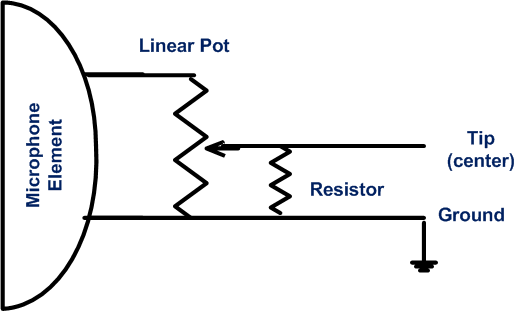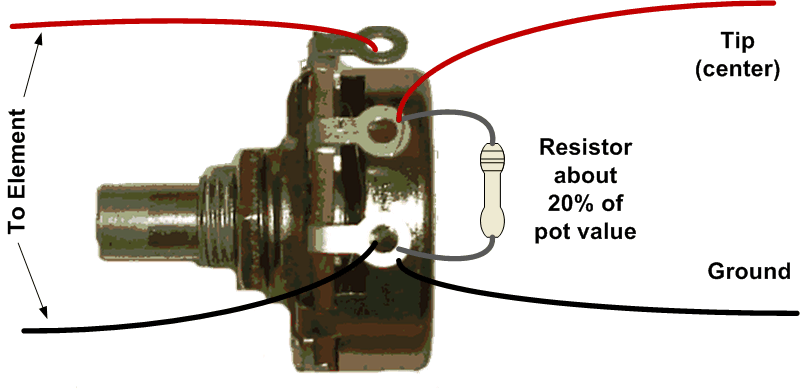Tweaking Linear Taper Pots
One of the big problems with working with high impedance mics is that a volume control potentiometer must be large enough to match both the element impedance and the input impedance of the amplifier. Volume control pots for high impedance mics feeding tube amps should be larger than 100K ohms and a 1-meg pot is a common value. The actual tonal difference, to my ears, between a 100k and a 5-meg is small. Other differences in the circuit, the qualities of the mic, the characteristics of the amp, and the acoustics of the room are much more noticeable than the small tone changes introduced by the volume pot.
The main problem, though with using a large value for the pot is the difficulty of finding an audio taper pot. Nobody makes potentiometers intended to be used in old analog equipment, anymore. Modern digital circuits work well enough with linear pots. I have not been able to find an inexpensive source for 1-meg audio pots, especially the tiny military pots that I use in my mic modifications.
I made some phone calls and discovered that the engineer who set up the carbon films used in making audio taper pots at one of the main manufacturers of pots, retired. He left without explaining to anyone how to do it. This may or may not be the reason that audio taper pots are rare, but I believe it.
Linear taper pots work as volume controls, but the response to turning the pot from zero to full on is not even. Because the sensitivity of the human ear is not linear and more logarithmic, the pot seems to do nothing for a long time and then suddenly go from mostly off to mostly on. This makes it difficult to fine-tune the volume. In practice a linear pot is just an on-off switch that allows a small amount of control of the volume.
For a while, I've been soldering a small resistor between the potentiometer's sweep and the ground. This seems to alleviate the linear pot's shortcomings a little. Recently, I decided to experiment a little and even went so far as to do the math and produce a little graph of the effect of adding a resistor to the volume control circuit.
This is the circuit.

And this is the graph of the resistance of the circuit.

As you can see the straight line of a linear pot now has a snaky S curve that is more linear in the first half, but with less of a slope. You have to turn the knob a little more to get a change in volume, where in the linear pot, a little turn gives more of a change. You can see that near the quiet side of the curve, you only have to turn a little to start getting sound. The top end still goes to full-on quickly in the last bit of turn.
The best size resistor is about 10 to 20 percent of the pot value. Bigger than that flattens out the S curve. Smaller than that creates a nearly flat place in the middle of the curve where nothing happens. One thing that happens is that the impedance on the amp side is never larger than the value of the added resistor. Adding a 200k resistor to a 1-meg pot gives good results. The element sees a mega-ohm impedance and the amp sees a maximum 200k impedance from the mic.
A lower impedance element like a Shure CM should be using a lower value for the pot and resistor.
Now, if you turn the mic's volume control to 1/2 or 3/4 and then turn the amp up as high as you can without feedback, you will be in the modified mic's sweet spot, and will have more fine control over the volume.
Here's how to solder up a small resistor to a volume pot (for those of you thrown by the circuit). It is just a regular volume control circuit with an extra resistor soldered between the sweep and the ground.

This mod should work well in guitar volume controls as well as in the amp itself. It will give a smoother sounding change in volume and more fine control. Guitar players, though, generally play at 100% volume, and the only way to quiet them down is to turn down their amps when they aren't looking.
